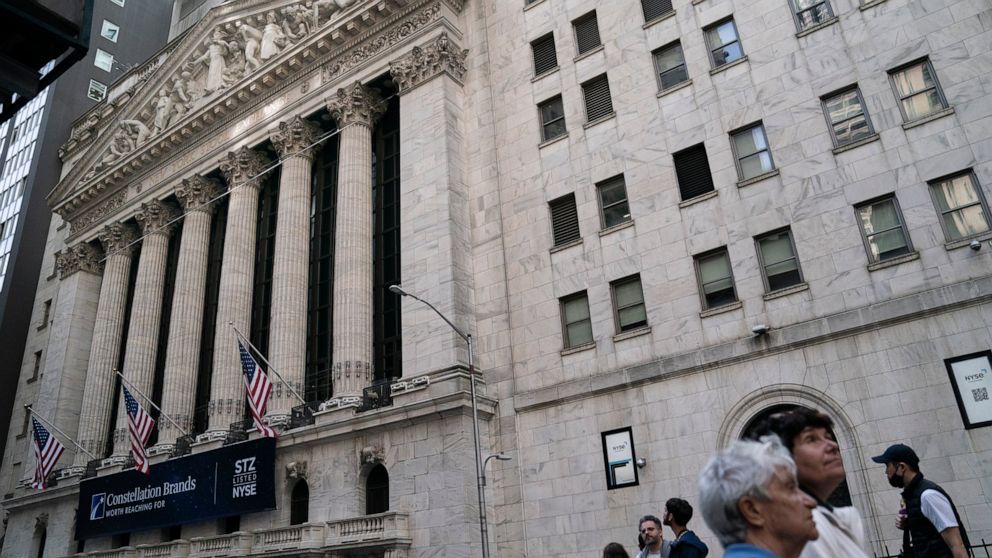Stocks rise as uncertainties keep Wall Street wobbly
NEW YORK — U.S. stocks are closing higher Tuesday after another wobbly day on Wall Street. Investors shook off worries about the economy and rising interest rates to lift the S&P 500 nearly 1%, after bouncing back from an early loss of the same size. Technology stocks were some of the biggest forces lifting the market thanks to a drop in Treasury yields. Stocks of energy producers also rose along with oil prices. That helped overshadow trouble at Target, which warned of lower profit margins as it slashes prices to clear out inventory. J.M. Smucker soared on strong quarterly results.
(asterisk)(asterisk)(asterisk)THIS IS A BREAKING NEWS UPDATE. AP’s previous story appears below.(asterisk)(asterisk)(asterisk)
U.S. stocks are ticking higher Tuesday on Wall Street despite worries about the economy and rising interest rates that have kept markets wobbling.
The S&P 500 was 0.5% higher in afternoon trading after bouncing back from an early loss of 1%. The Dow Jones Industrial Average was up 147 points, or 0.4%, at 33,060, as of 3 p.m. Eastern time. It also swung between losses and gains throughout the day. The Nasdaq composite was 0.5% higher.
Gains for Apple, Microsoft and other technology stocks were some of the biggest forces driving the market higher. They benefited from a drop in Treasury yields, with the 10-year yield falling back below 3%. Lower yields in recent years have emboldened investors to pay higher prices for stocks, particularly companies that are growing quickly.
Stocks of energy producers also jumped as oil prices rose to roughly $120 per barrel, up more than 55% for the year so far. Exxon Mobil climbed 4.2%, and ConocoPhillips added 3.9%.
Kohl’s soared 9% after the department store chain said it’s in advanced talks to sell itself for about $8 billion to Vitamin Shoppe owner Franchise Group. Jam maker J.M. Smucker rose 5.7% after reporting strong earnings.
Wall Street started the day with more pessimism, and stocks initially fell after Target warned of a hit to its profit margins as it slashes prices to clear out inventory. The retail giant sank 3.2% after it announced the moves needed to keep up with customers’ changing behaviors. Across the country, shoppers are spending more at restaurants and on travel than on sprucing up their homes as they did earlier in the pandemic.
Other retailers got caught in the downdraft, and Walmart fell 1.3%.
Worries were also stoked by the World Bank sharply cutting its forecast for economic growth this year. It pointed to Russia’s war against Ukraine and the prospect of widespread food shortages, raising the potential return of “ stagflation,” a toxic mix of high inflation and sluggish growth unseen for more than four decades.
The economy’s fragility has been atop Wall Street’s mind this year amid worries about interest-rate hikes coming from the Federal Reserve. The central bank is moving aggressively to stamp out the worst inflation in decades, but it risks choking off the economy if it moves too far or too quickly.
The Fed is widely expected to raise its key short-term interest rate by half a percentage point at its meeting next week. That would be the second straight increase of double the usual amount, and investors expect a third in July.
The Fed is not alone in reining in the massive support thrown at the economy and financial markets during the pandemic. Australia’s central bank surprised investors Tuesday by raising interest rates by half a percentage point.
Even if central banks pull off the delicate act of slowing the economy enough to halt inflation but not so much as to cause a recession, markets face other challenges.
“Rising rates and slowing growth are not a supportive environment for investors, so it is unlikely that equity or fixed income returns will match the stimulus-fueled returns of the past two years,” Gargi Chaudhuri, head of iShares investment strategy, Americas, said in a report. She doesn’t think the U.S. will fall into a recession.
Treasury yields have largely climbed through this year with expectations for a more aggressive Fed. They moderated a bit on Tuesday, though.
The yield on the 10-year Treasury fell back to 2.97% from 3.03% late Monday. The two-year yield, which more closely tracks expectations for Fed action, dipped more modestly to 2.72% from 2.73%.
Markets could remain erratic until more clarity emerges over inflation and the economy. The next big update on inflation arrives Friday, when the U.S. government releases its latest reading on the consumer price index.
![]()


